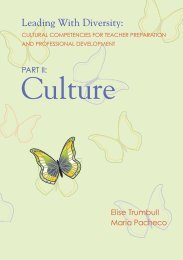School-Linked Services: Child Opportunity Zone Family Centers
School-Linked Services: Child Opportunity Zone Family Centers
School-Linked Services: Child Opportunity Zone Family Centers
Create successful ePaper yourself
Turn your PDF publications into a flip-book with our unique Google optimized e-Paper software.
The Effectiveness of<br />
<strong>School</strong>-<strong>Linked</strong> <strong>Services</strong><br />
<strong>School</strong>-linked services can improve child<br />
and family well-being. Some examples of<br />
indicators that have been positively<br />
impacted by school-linked family center<br />
initiatives in other states include:<br />
Improvements in:<br />
Student achievement.<br />
Parent participation in the schools.<br />
Improved classroom behavior.<br />
Enrollment in Medicaid and other benefit<br />
programs.<br />
Access to health and dental care<br />
Access to child care and transportation.<br />
Parenting skills and family functioning.<br />
Reductions in:<br />
Student mobility.<br />
<strong>School</strong> violence.<br />
Suspension rates and unexcused absences.<br />
Grade retention.<br />
Unmet needs for food and clothing.<br />
<strong>School</strong>-linked family centers are most<br />
effective when the following elements are<br />
supported by resource allocation and<br />
program design:<br />
Program Development:<br />
There are active and equal partnerships<br />
among schools, families, and community<br />
agencies.<br />
Efforts are well-integrated into the life of<br />
the school.<br />
Parents are more involved with site<br />
activities.<br />
Program Implementation:<br />
<strong>Services</strong> are two-generational - focusing on<br />
the child and family.<br />
<strong>Services</strong> are culturally competent.<br />
A mix of both prevention and<br />
intervention programs are available.<br />
Programs are flexible in responding to<br />
family needs and work with families over<br />
time.<br />
State <strong>School</strong>-<strong>Linked</strong><br />
Service Programs<br />
Efforts are underway in states across the<br />
country to build networks of schoollinked<br />
family centers and to foster<br />
community partnerships that make health<br />
and human services more accessible to<br />
families and students. Two examples of<br />
school-linked service efforts that are<br />
showing promise include:<br />
Kentucky <strong>Family</strong> Resource and<br />
Youth <strong>Services</strong> <strong>Centers</strong><br />
Kentucky’s Education Reform Act of<br />
1990 authorized support for <strong>Family</strong><br />
Resource and Youth Service <strong>Centers</strong> in all<br />
elementary and high schools in which<br />
20 percent or more of the students are<br />
eligible for free or reduced-price lunches.<br />
The <strong>Centers</strong> are designed to coordinate a<br />
community’s social and health services for<br />
students and their families. Although the<br />
centers provide some services directly, the<br />
majority of efforts focus on accessing<br />
existing community services for families.<br />
Typical program components include<br />
preschool and after-school child care,<br />
information and referral, and family<br />
support services.<br />
The <strong>School</strong> of the 21 st Century<br />
The <strong>School</strong> of the 21st Century was<br />
initiated in 1987 by the Bush Center on<br />
<strong>Child</strong> Development and Social Policy at<br />
Yale University. Communities across the<br />
country follow guiding principles set by<br />
the Yale Bush Center and receive training<br />
and technical assistance through an annual<br />
institute. The basic components of the<br />
program - child care, information and<br />
referral, home visits to new and expectant<br />
parents, and a network of family child care<br />
providers - are designed in accordance<br />
with community resources and needs.<br />
“All over the country,<br />
school and community<br />
people are putting<br />
together the pieces to<br />
help schools meet the<br />
varied needs of today’s<br />
students and their<br />
parents. I call the product<br />
of these collaborative<br />
efforts full-service schools.<br />
The full-service school is a<br />
homegrown product that<br />
can take many shapes:<br />
community schools,<br />
lighted school houses<br />
called Beacons, schoolbased<br />
clinics, family<br />
resource centers.” Joy<br />
Dryfoos, “Full-Service<br />
<strong>School</strong>s”, Educational<br />
Leadership, 1996<br />
full-service schools<br />
7



